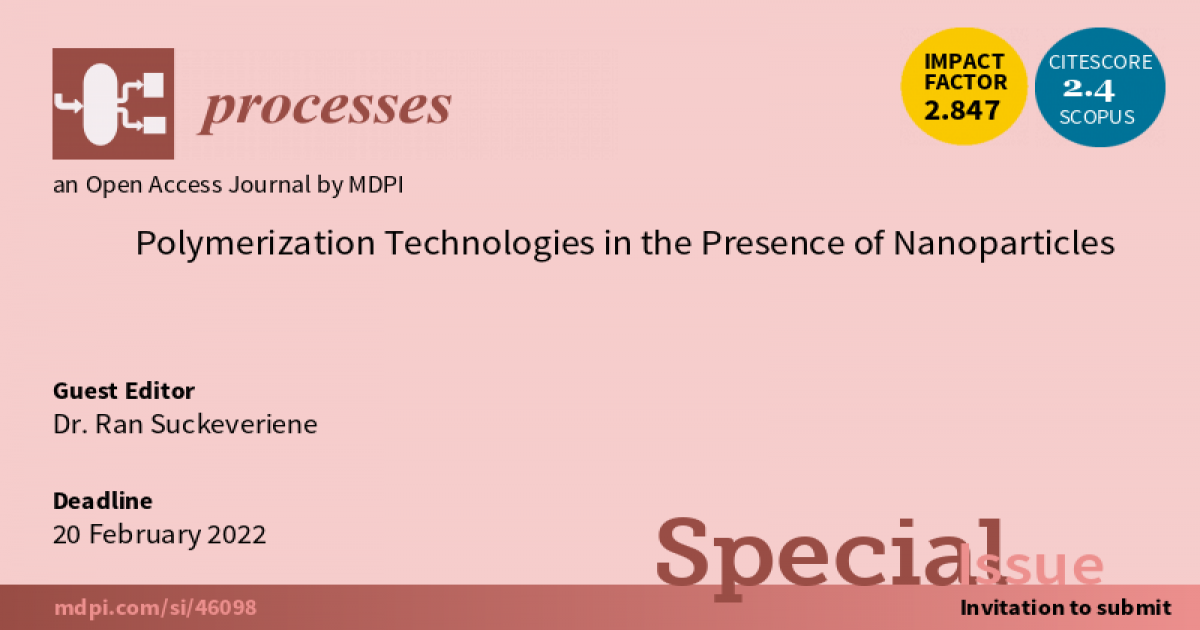Polymerization Technologies in the Presence of Nanoparticles
A special issue of Processes (ISSN 2227-9717). This special issue belongs to the section "Materials Processes".
Deadline for manuscript submissions: closed (20 February 2022) | Viewed by 11639

Special Issue Editor
Interests: polymer synthesis and processing; advanced polymers and nanocomposites; electrically conductive polymers and composites; hydrophilic and hydrophobic surface modifications; anti-microbial and anti-biofouling surfaces; polymer and composites characterization techniques
Special Issue Information
Dear Colleagues,
Polymeric nanocomposites are attracting significant attention as advanced materials and their applications in many fields, such as electrical and electronic, automotive and transportation, architecture and construction, and sports. For a long time, there has been a need for the development of polymeric materials with specific properties that require high functionality. To meet their needs, many nanocomposites with high functionality are newly researched and developed. High-functional nanocomposites must exhibit mechanical, electronic, or chemical performance in harsher and tougher conditions than normal.
This Special Issue Introduces the different approaches for polymerization techniques in the presence of nanoparticles. This Special Issue Introduces a wide range of high-functional nanocomposites such as high-performance polymers, high-temperature polymers, engineering materials for flexible displays, super-engineering polymers, high gas barrier films, and liquid crystalline polymers, etc.
This Special Issue will demonstrate the multidisciplinary aspect of the selected subject and bring together original papers and reviews covering (but not restricted to) the following topics:
- Advanced design of nanocomposites with functional polymers and nanoparticles;
- Development of controlled delivery systems based on nanocomposites;
- Grafting of polymer chains to nanoparticle surfaces;
- Drugs delivery incorporating nanoparticles in nanomedicine;
- Design of smart nano-objects for target applications in EOR (enhanced oil recovery), pharmacy, agriculture, and water purification.
Dr. Ran Suckeveriene
Guest Editor
Manuscript Submission Information
Manuscripts should be submitted online at www.mdpi.com by registering and logging in to this website. Once you are registered, click here to go to the submission form. Manuscripts can be submitted until the deadline. All papers will be peer-reviewed. Accepted papers will be published continuously in the journal (as soon as accepted) and will be listed together on the special issue website. Research articles, review articles as well as short communications are invited. For planned papers, a title and short abstract (about 100 words) can be sent to the Editorial Office for announcement on this website.
Submitted manuscripts should not have been published previously, nor be under consideration for publication elsewhere (except conference proceedings papers). All manuscripts are thoroughly refereed through a single-blind peer-review process. A guide for authors and other relevant information for submission of manuscripts is available on the Instructions for Authors page. Processes is an international peer-reviewed open access monthly journal published by MDPI.
Please visit the Instructions for Authors page before submitting a manuscript. The Article Processing Charge (APC) for publication in this open access journal is 2000 CHF (Swiss Francs). Submitted papers should be well formatted and use good English. Authors may use MDPI's English editing service prior to publication or during author revisions.
Keywords
- polymerization
- nanoparticles
- nanocomposites
- in situ
- post-polymerization modification
- grafting
- step polymerization
- polycondensation
- controlled polymerization
- free-radical polymerization
Benefits of Publishing in a Special Issue
- Ease of navigation: Grouping papers by topic helps scholars navigate broad scope journals more efficiently.
- Greater discoverability: Special Issues support the reach and impact of scientific research. Articles in Special Issues are more discoverable and cited more frequently.
- Expansion of research network: Special Issues facilitate connections among authors, fostering scientific collaborations.
- External promotion: Articles in Special Issues are often promoted through the journal's social media, increasing their visibility.
- Reprint: MDPI Books provides the opportunity to republish successful Special Issues in book format, both online and in print.
Further information on MDPI's Special Issue policies can be found here.





